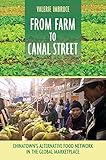From Farm to Canal Street : Chinatown's Alternative Food Network in the Global Marketplace / Valerie Imbruce.
Material type: TextPublisher: Ithaca, NY : Cornell University Press, [2016]Copyright date: ©2016Description: 1 online resource (232 p.) : 12 halftones, 13 tables, 7 chartsContent type:
TextPublisher: Ithaca, NY : Cornell University Press, [2016]Copyright date: ©2016Description: 1 online resource (232 p.) : 12 halftones, 13 tables, 7 chartsContent type: - 9781501701238
- Chinese Americans -- Food -- New York (State) -- New York
- Food habits -- New York (State) -- New York
- Food supply -- New York (State) -- New York
- Produce trade -- New York (State) -- New York
- Agriculture
- U.S. History
- SOCIAL SCIENCE / Agriculture & Food (see also POLITICAL SCIENCE / Public Policy / Agriculture & Food Policy)
- where do fruits come from, where do vegetables come from, paths of produce, farming industry
- 381/.4108995107471 23
- online - DeGruyter
| Item type | Current library | Call number | URL | Status | Notes | Barcode | |
|---|---|---|---|---|---|---|---|
 eBook
eBook
|
Biblioteca "Angelicum" Pont. Univ. S.Tommaso d'Aquino Nuvola online | online - DeGruyter (Browse shelf(Opens below)) | Online access | Not for loan (Accesso limitato) | Accesso per gli utenti autorizzati / Access for authorized users | (dgr)9781501701238 |
Browsing Biblioteca "Angelicum" Pont. Univ. S.Tommaso d'Aquino shelves, Shelving location: Nuvola online Close shelf browser (Hides shelf browser)

|

|

|

|

|

|

|
||
| online - DeGruyter French Sociology / | online - DeGruyter American Pendulum : Recurring Debates in U.S. Grand Strategy / | online - DeGruyter The Concerned Women of Buduburam : Refugee Activists and Humanitarian Dilemmas / | online - DeGruyter From Farm to Canal Street : Chinatown's Alternative Food Network in the Global Marketplace / | online - DeGruyter Reframing Decadence : C. P. Cavafy's Imaginary Portraits / | online - DeGruyter Nested Security : Lessons in Conflict Management from the League of Nations and the European Union / | online - DeGruyter Becoming Bourgeois : Love, Kinship, and Power in Provincial France, 1670–1880 / |
Frontmatter -- Contents -- Preface -- Introduction: Situating Manhattan’s Chinatown -- 1. Greengrocers and Street Vendors -- 2. The Social Network of Trade -- 3. Okeechobee Bok Choy -- 4. Bringing Southeast Asia to the Southeastern United States -- 5. Growing Asian Vegetables in Honduras -- 6. Chinese Food in American Culture -- 7. Chinatown’s Food Network and New York City Policies -- Conclusion: Diversity and Dynamism in Global Markets -- Appendix A: Produce Vendors in Chinatown -- Appendix B: Fresh Fruit, Vegetables, and Herbs Sold in Chinatown -- Appendix C: Food Plants Found in Southeast Asian Homegardens in Miami-Dade County, Florida -- Appendix D: Research Methods -- Notes -- References -- Index
restricted access online access with authorization star
http://purl.org/coar/access_right/c_16ec
On the sidewalks of Manhattan's Chinatown, you can find street vendors and greengrocers selling bright red litchis in the summer and mustard greens and bok choy no matter the season. The neighborhood supplies more than two hundred distinct varieties of fruits and vegetables that find their way onto the tables of immigrants and other New Yorkers from many walks of life. Chinatown may seem to be a unique ethnic enclave, but it is by no means isolated. It has been shaped by free trade and by American immigration policies that characterize global economic integration. In From Farm to Canal Street, Valerie Imbruce tells the story of how Chinatown's food network operates amid—and against the grain of—the global trend to consolidate food production and distribution. Manhattan’s Chinatown demonstrates how a local market can influence agricultural practices, food distribution, and consumer decisions on a very broad scale.Imbruce recounts the development of Chinatown’s food network to include farmers from multimillion-dollar farms near the Everglades Agricultural Area and tropical "homegardens" south of Miami in Florida and small farms in Honduras. Although hunger and nutrition are key drivers of food politics, so are jobs, culture, neighborhood quality, and the environment. Imbruce focuses on these four dimensions and proposes policy prescriptions for the decentralization of food distribution, the support of ethnic food clusters, the encouragement of crop diversity in agriculture, and the cultivation of equity and diversity among agents in food supply chains. Imbruce features farmers and brokers whose life histories illuminate the desires and practices of people working in a niche of the global marketplace.
Mode of access: Internet via World Wide Web.
In English.
Description based on online resource; title from PDF title page (publisher's Web site, viewed 26. Apr 2024)


